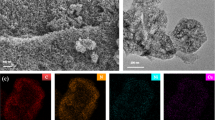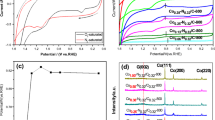Abstract
The metal oxide/nitrogen-doped carbon (NC) compounds zirconium oxide/NC (ZrO2/NC) and cerium oxide/NC (CeO2/NC) were synthesized via the pyrolysis of polyaniline on the metal oxide surface. The characterization of the ZrO2/NC and CeO2/NC catalysts showed more active CO2 reduction reaction activity than that of NC catalyst without metal oxide. Gas chromatography analysis revealed that CO and H2 were the primary products, and no liquid-phase products were detected via proton nuclear magnetic resonance spectroscopy or high-performance liquid chromatography. The maximum Faraday efficiency of ZrO2/NC reached 90% at − 0.73 V (vs. RHE), with the current density of CO at 5.5 mA/cm2; this Faraday efficiency value was higher than that of NC (41%), with the current density of CO at 3.1 mA/cm2. The interaction between the metal oxide and carbon allowed the efficient formation of defect sites, especially imine-type nitrogen, strengthening the adsorption of the key reaction intermediate CO2•− and thus promoting the CO2 reduction reaction.








Similar content being viewed by others
References
Yan CC, Li HB, Ye YF et al (2018) Coordinatively unsaturated nickel–nitrogen sites towards selective and high-rate CO2 electroreduction. Energy Environ Sci 11(5):1204–1210
Zhu DD, Liu JL, Qiao SZ (2016) Recent advances in inorganic heterogeneous electrocatalysts for reduction of carbon dioxide. Adv Mater 28(18):3423–3452
Hamann TW, Jensen RA, Martinson ABF et al (2008) Advancing beyond current generation dye-sensitized solar cells. Energy Environ Sci 1(1):66
He X, Qiu LQ, Wang WJ et al (2020) Photocarboxylation with CO2: an appealing and sustainable strategy for CO2 fixation. Green Chem 22(21):7301–7320
Li JS, Tian Y, Zhou YN et al (2020) Abiotic-biological hybrid systems for CO2 conversion to value-added chemicals and fuels. Trans Tian** Univ 26(4):237–247
Chang Q, Kim J, Lee JH et al (2020) Boosting activity and selectivity of CO2 electroreduction by pre-hydridizing Pd nanocubes. Small 16(49):2005305
**e H, Wan YY, Wang XM et al (2021) Boosting Pd-catalysis for electrochemical CO2 reduction to CO on Bi-Pd single atom alloy nanodendrites. Appl Catal B Environ 289:119783
Ma C, Hou PF, Wang XP et al (2019) Carbon nanotubes with rich pyridinic nitrogen for gas phase CO2 electroreduction. Appl Catal B Environ 250:347–354
Hou PF, Song WL, Wang XP et al (2020) Well-defined single-atom cobalt catalyst for electrocatalytic flue gas CO2 reduction. Small 16(24):2001896
Yadav A, Kumar H, Sharma R et al (2021) Influence of polyaniline on the photocatalytic properties of metal nanocomposites: a review. Colloid Interface Sci 40:100339
Mohamad AIZ, Wadi HS, Gan SN et al (2018) Polyaniline (PAni) optical sensor in chloroform detection. Sensor Actuat B Chem 261:97–105
Li YQ, Mao YL, **ao C et al (2020) Flexible pH sensor based on a conductive PANI membrane for pH monitoring. RSC Adv 10(1):21–28
Ahmad AL, Farooqui UR, Hamid NA (2018) Porous (PVDF-HFP/PANI/GO) ternary hybrid polymer electrolyte membranes for lithium-ion batteries. RSC Adv 8(45):25725–25733
Li LM, Liu EH, Shen HJ et al (2011) Charge storage performance of doped carbons prepared from polyaniline for supercapacitors. J Solid State Electrochem 15(1):175–182
Yan J, Wei T, Qiao WM et al (2010) A high-performance carbon derived from polyaniline for supercapacitors. Electrochem Commun 12(10):1279–1282
Yin YL, Gao Y, Zhang YL et al (2019) Synthesis of honeycomb-like hierarchical porous carbon via molten salt pyrolysis in a novel sequencing integration system for high-performance supercapacitors. Microporous Mesoporous Mater 278:195–205
Taheri NN, Ramezanzadeh B, Mahdavian M (2019) Application of layer-by-layer assembled graphene oxide nanosheets/polyaniline/zinc cations for construction of an effective epoxy coating anti-corrosion system. J Alloy Compd 800:532–549
Li F, Li GX, Zeng J et al (2014) Molybdate-doped copolymer coatings for corrosion prevention of stainless steel. J Appl Polym Sci 131(16):40602
Wang H, Jia J, Song PF et al (2017) Efficient electrocatalytic reduction of CO2 by nitrogen-doped nanoporous carbon/carbon nanotube membranes: a step towards the electrochemical CO2 refinery. Angew Chem 129(27):7955–7960
Trchová M, Stejskal J (2011) Polyaniline: the infrared spectroscopy of conducting polymer nanotubes (IUPAC Technical Report). Pure Appl Chem 83(10):1803–1817
Kim JH, Woo H, Choi J et al (2017) CO2 electroreduction on Au/TiC: enhanced activity due to metal–support interaction. ACS Catal 7(3):2101–2106
Han H, ** S, Park S et al (2021) Plasma-induced oxygen vacancies in amorphous MnOx boost catalytic performance for electrochemical CO2 reduction. Nano Energy 79:105492
Yuan LP, Jiang WJ, Liu XL et al (2020) Molecularly engineered strong metal oxide–support interaction enables highly efficient and stable CO2 electroreduction. ACS Catal 10(22):13227–13235
Hao LD, Sun ZY (2021) Metal oxide-based materials for electrochemical CO2 reduction. Acta Phys Chimica Sin 37(7):2009033
Tauster SJ, Fung SC, Garten RL (1978) Strong metal-support interactions. Group 8 noble metals supported on titanium dioxide. J Am Chem Soc 100(1):170–175
Tauster SJ (1987) Strong metal-support interactions. Acc Chem Res 20(11):389–394
Tao HC, Choi C, Ding LX et al (2019) Nitrogen fixation by Ru single-atom electrocatalytic reduction. Chem 5(1):204–214
Han ZS, Choi C, Tao HC et al (2018) Tuning the Pd-catalyzed electroreduction of CO2–CO with reduced overpotential. Catal Sci Technol 8(15):3894–3900
Kumar B, Asadi M, Pisasale D et al (2013) Renewable and metal-free carbon nanofibre catalysts for carbon dioxide reduction. Nat Commun 4:2819
Wu JJ, Sharifi T, Gao Y et al (2019) Emerging carbon-based heterogeneous catalysts for electrochemical reduction of carbon dioxide into value-added chemicals. Adv Mater 31(13):1804257
Chu J, Li X, Li QQ et al (2020) Hydrothermal synthesis of PANI nanowires for high-performance supercapacitor. High Perform Polym 32(3):258–267
de Castro SI, Sigoli FA, Mazali IO (2017) Reversible oxygen vacancy generation on pure CeO2 nanorods evaluated by in situ Raman spectroscopy. J Phys Chem C 121(23):12928–12935
Villa-Aleman E, Houk AL, Dick DD et al (2020) Hyper-Raman spectroscopy of CeO2. J Raman Spectrosc 51(7):1260–1263
Ji P, Wang Z, Shang XH et al (2019) Direct observation of enhanced Raman scattering on nano-sized ZrO2 substrate: charge-transfer contribution. Front Chem 7:245
Silge A, Bocklitz T, Ossig R et al (2016) The interaction of an amino-modified ZrO2 nanomaterial with macrophages–an in situ investigation by Raman microspectroscopy. Anal Bioanal Chem 408(21):5935–5943
Melánová K, Beneš L, Zima V et al (2019) Microcomposites of zirconium phosphonates with a conducting polymer, polyaniline: preparation, spectroscopic study and humidity sensing. J Solid State Chem 276:285–293
Rajagopal RV, Venkata PC (2018) Surface chemical states, electrical and carrier transport properties of Au/ZrO2/n–GaN MIS junction with a high-k ZrO2 as an insulating layer. Mater Sci Eng: B 231:74–80
Li WH, Nie XW, Jiang X et al (2018) ZrO2 support imparts superior activity and stability of Co catalysts for CO2 methanation. Appl Catal B Environ 220:397–408
Holgado JP, Alvarez R, Munuera G (2000) Study of CeO2 XPS spectra by factor analysis: reduction of CeO2. Appl Surf Sci 161(3–4):301–315
Yang CW, Bebensee F, Chen J et al (2017) Carbon dioxide adsorption on CeO2(110): an XPS and NEXAFS study. ChemPhysChem 18(14):1874–1880
Zhang K, Zhang LL, Zhao XS et al (2010) Graphene/polyaniline nanofiber composites as supercapacitor electrodes. Chem Mater 22(4):1392–1401
Chen SH, Zhao XL, **e FZ et al (2020) Efficient charge separation between ZnIn2S4 nanoparticles and polyaniline nanorods for nitrogen photofixation. New J Chem 44(18):7350–7356
Acknowledgements
The work was supported by the National Key R&D Program of China (No. 2016YFB0600901) and Changyi Hydrogen Industrial Technology Fund.
Author information
Authors and Affiliations
Corresponding author
Rights and permissions
About this article
Cite this article
Shi, H., Cheng, Y. & Kang, P. Metal Oxide/Nitrogen-Doped Carbon Catalysts Enables Highly Efficient CO2 Electroreduction. Trans. Tian** Univ. 27, 269–277 (2021). https://doi.org/10.1007/s12209-021-00287-7
Received:
Revised:
Accepted:
Published:
Issue Date:
DOI: https://doi.org/10.1007/s12209-021-00287-7




